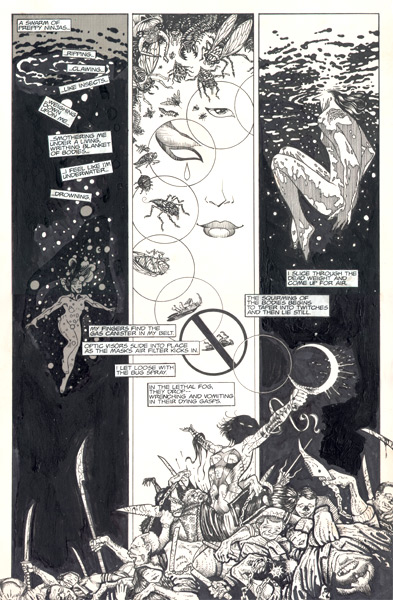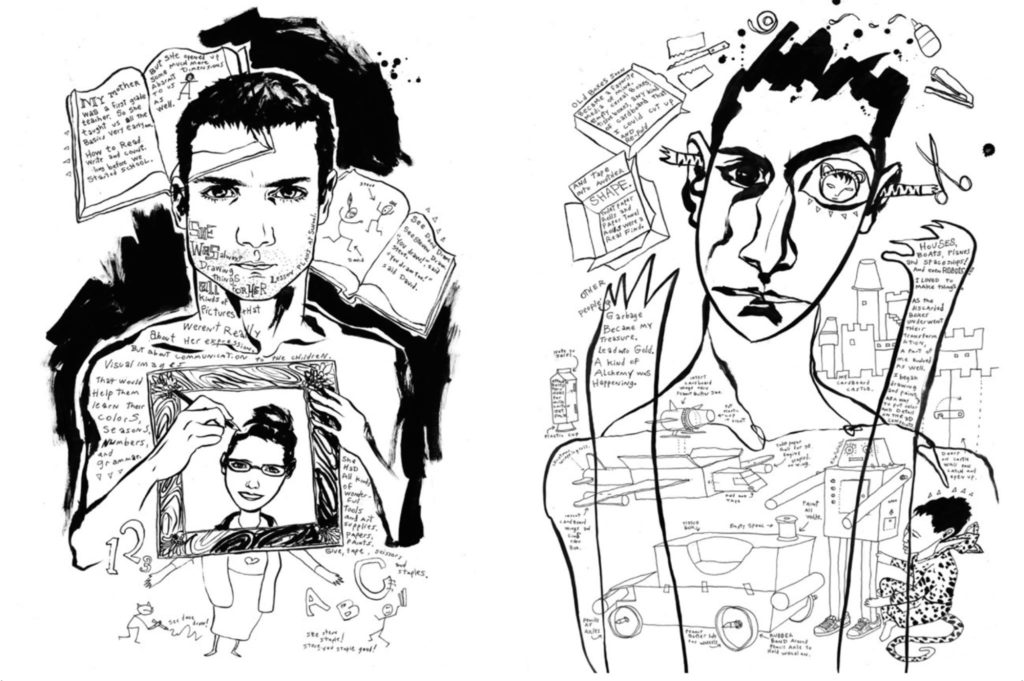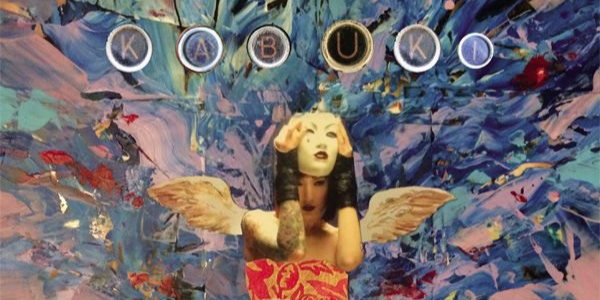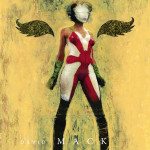When it comes to creators who really push the boundaries of what comics can do, the name that automatically pops into my mind is David Mack. To me, Mack’s work epitomizes the melding of the “visual” with the “narrative,” emphasizing comics as an art form as well as a storytelling medium. I have admired his work since a wise comic book dealer introduced me to Kabuki: Circle of Blood almost 20 years ago. My original trade edition from Caliber Comics has since been loved to pieces. How convenient that Dark Horse has begun reprinting Kabuki in four gorgeous hardcover library editions, each collecting the pieces of the character and her creator’s evolution. Volume three was released just in time for SDCC, where I had the opportunity to speak with Mack about this book and his many other projects—and to indulge my curiosity. Because every time I turn a page in Kabuki’s life, I find myself wishing for a peek into the creator’s mind and to understand the process that shapes the transformations I see before me.
The irony is that Mack initially only considered himself to be the writer for Kabuki, despite his studies in graphic design, sculpture, art history, painting, drawing, photography, bookmaking, and typography. Those classes focused on art in a myriad of mediums, but none of them touched on the art of comics. So, in the early ’90s, Mack found himself looking for an artist to bring Kabuki—his senior writing thesis—to life. He had hoped to work with Brian Michael Bendis on this story of a government operative in a near-future Japan who breaks the bonds of her oppression. Instead, they got to chatting about various inking styles, and Bendis helped get Mack a job as an inker. Opportunities to contribute to various anthologies arose. In an eight-page contribution, Mack was able to flesh out his character and explore scenes from different perspectives. The process turned out to be an excellent opportunity for research and development, something Mack recommends aspiring artists try out for themselves to gain an understanding of the many elements involved, such as the time ratio of converting text to image. The scenes Mack created for the anthologies were collected into a one-shot and shortly after, Mack jokes, he had tricked himself into drawing Circle of Blood himself.

The artistic transitions between Circle of Blood and Mack’s later stories about the character seem starkly different, with the most notable difference being the original harsh lines of a black and white, cyber-punk, noir style. “As a writer, I like the idea of visuals that support the feel of the story,” he says. Much of Circle of Blood moves through the reality of Kabuki’s violent life as an operative and the intersection of politics and organized crime. When the story changes to Kabuki’s very personal, very internal struggle to overcome her inner demons and find herself with the help of a not-so-imaginary friend, the art changes accordingly to soft, water-colour collages and seemingly simplistic inks to create a beautiful, surreal, flowing story that almost rises off of the page.
Mack’s skills encompass various artistic mediums, many of which can be seen in the culmination of Kabuki’s story over in the third volume of Dark Horse’s library editions. At over 400 pages each, the collections gather Circle of Blood and Dreams, Skin Deep and Metamorphosis, and now The Alchemy, originally published in 2004, where Kabuki follows the origami keys left by the enigmatic Akemi, who seems to have a worldwide network of connections that form the pieces of some kind of revolution that Kabuki is to play a part in. The fourth volume, which will be published in November, collects the Masks of the Noh and Scarab stories, where Kabuki’s former allies are sent on a simple mission: Find Kabuki. “If she’s dead, bring back her corpse. If she’s alive … bring back her corpse.”
The collected editions also include many, many extras. There are the expected art pages and some bonus stories, commentary and insights into his other works, such as the afterword for Philip K. Dick’s Do Androids Dream of Electric Sheep, his work with Tori Amos, theatrical art, and works commissioned by museums and others. But what truly makes this edition special to me as a collector and as a long time admirer of Mack’s work, are the letters and notes and odds and ends—the pieces of the puzzles that come together to form the collage of Kabuki’s life and of Mack himself. Writes G.D. Kennedy at the 13th Dimension:
“The final volume of Kabuki’s story—The Alchemy—is a story about evolution, of artistic creation and exploration of self and purpose. It is, in many ways, a primer on artistic creation and endeavor, not so much driven by external plot lines but by internal forces.”
Reading the additional notes, including the introduction by Chuck Palahniuk with whom Mack currently works on Fight Club 2:
“Art is the lie that tells the truth better than the truth. And in Kabuki, David Mack tells you more about his life than he could ever tell you in person. Using his past instead of being used by it. Building a metaphor that allows people to see and explore their own experience.
“It’s the job of any creative person to explore and express what other people can’t.
“You’re always seeing your life as something within a larger pattern. Your experience is never just yours—it’s only one aspect of something occurring in a million, zillion other lives. You become a listener, a watcher, a witness, pulling together the stories of other people to illustrate a larger theme.”
It should come as no surprise when Mack himself appears within The Alchemy. In a surreal experience that, for me, is reminiscent of the airplane scene in Palahniuk’s Fight Club, Mack has a conversation with Kabuki that he describes as “the groundwork for a kind of Mobius strip structure for the story at the end.”

Like many other aspects of the story, it mingles the reality of the pieces of Mack’s life with the pieces that Kabuki is putting together in her search for truth and self. The circular connection between reality and fantasy is profound, as elements Mack created within the story found their own place in reality, such as The Shy Creatures, a children’s book we see Kabuki reading that was later published by Feiwel & Friends. “It seemed like the ideas that I’d write into the story, would find a way of becoming real,” Mack writes in the notes of volume three.
The Alchemy also incorporates contributions from readers and bits and pieces of correspondences Mack has had with his colleagues. From the stamps that decorate Akemi’s letters from around the world, to bits of fabric from Miss Fumiko of the First Zen Institute of America. My favourite piece of bonus material are the sample scripts.
I was curious about how Mack turns these words into the final product. He explained that he works with several different layout ideas for each scene before finally choosing the one that visually communicates what the story needs to say. The complexity of each page made me wonder how Mack felt about the turn to digital comics, in particular, guided reading which breaks pages into their individual parts which, considering how much exists on a single page of Mack’s work, comes with the risk of losing elements that fall outside of the standard panels. His answer surprised me. He normally views each page as a whole, being conscious of how the colours and format of each complements its opposing page. The panel by panel digital view simply offers him an entirely new perspective with which to see his work. As with anything, perspective is all, and Mack is never afraid to expand his vision to encompass other points of view. Nowhere is this truer than in his work with the art studio, Visionaries & Voices, where artists faced with challenges like autism or dyslexia can use art to relate to the world on their own terms.
In his notes, Mack points out that his scripts differ when he works with other artists, though, as an artist himself, he is able to provide a sense of what he is thinking through layouts and sketches as a “jumping point,” though he does not expect artists like Joe Quesada, with whom he worked on Daredevil, or the various artists who worked on Masks of the Noh, to feel bound to his designs. Writing for other, more experienced artists is a challenge that Mack enjoys, calling it a “crash course in communicating.”
While he does have new ideas for Kabuki, inspired by the recent relaunch of Dark Horse Presents in which he wrote a new story for the character, Mack is never not busy. His art graces many books, including Palahniuk’s Fight Club 2 and the recently announced continuation of the Jessica Jones Alias series with its original team of writer Brian Michael Bendis and artist Michael Gaydos, with Mack on covers. You’ll see more of Mack and Jessica Jones’ names together in the opening theme of the Netflix series. Unsurprisingly, he’s also branched into the world of animation after a request from Jack and Amanda Palmer to create a music video for “1952 Vincent Black Lightning.”
The chance to chat with Mack and to peer into a mind that I admire so much was, undeniably, one of the highlights of my SDCC experience. For now, my curiosity is sated, but I cannot wait to discover what further secrets and insights he will reveal within the fourth and final library edition of Kabuki. My bookshelf is ready.





